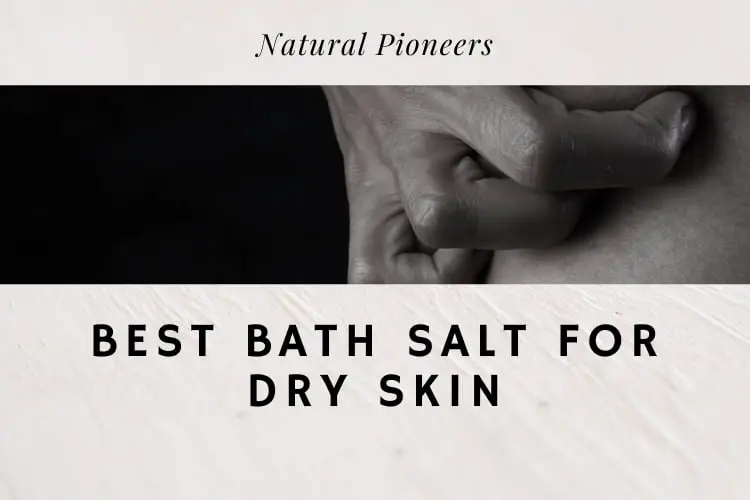
When dealing with dry skin there’s a lot you can do wrong, which will only worsen your skin condition. This article will tell you what evidence-based bath salts work for dry skin, and in addition teach you the dos and don’ts of a healthy bathing routine for dry skin.
Best Bath Salt For Dry Skin
#1: Dead Sea Salts
#2: Colloidal Oatmeal
#3: Rice Starch
#4: Sea Salt
#5: No-Salts
Let’s start with the dos and don’ts when dealing with dry skin and then take a close look at the benefits of each of the 5 best bath salts in the treatment of dry skin.
1. Do You Have Dry Skin?
There are three major skin types: dry, oily, and combination skins. If you have dry skin, your skin needs extra care and consideration when taking baths. Let’s first make sure know what dry skin is.
Dry skin, also called xerosis, is a common skin condition that can occur at all ages. It usually doesn’t represent a serious problem – it’s just annoying.
If you have dry skin, your skin might appear dehydrated, peeled, inflamed, and or irritated. It might feel rough, scaly, and itchy. Fine lines or cracks and gray, ashy skin are other symptoms of dry skin. [1]; [2]
Dealing with acne and blemished skin? Read more: Is Dead Sea Mud Good For Acne?
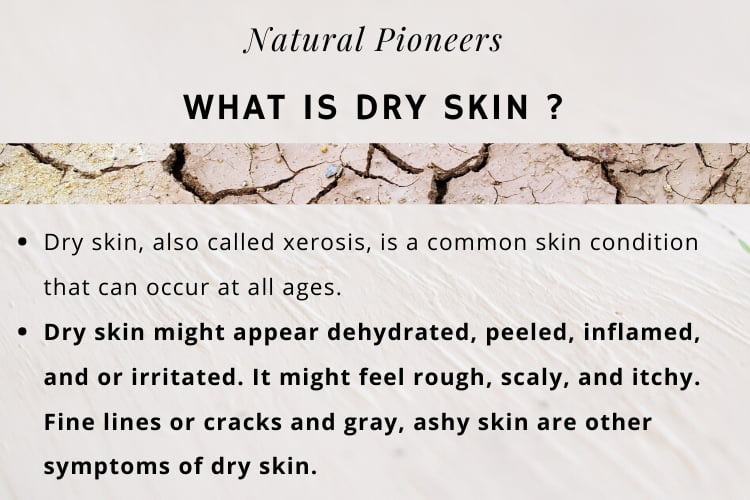
2. Dos And Don’ts
Specifically when looking for a bath salt and dealing with dry skin, be aware that hot and long baths or showers can be one of many causes of dry skin. While baths can definitely be of help, make sure you know your dos and don’ts when battling with dry skin.
Dry Skin | Dos
- Take at least one bath or shower a day
- Bathe or shower in lukewarm (not hot) water
- Use a gentle cleanser (not soap)
- Use a moisturizer for dry skin twice a day to improve hydration and protect the skin barrier
- Moisturize hands every time you wash them
- Schedule your bathing and moisturizing routine at night, just before bed. This can help your skin better retain its moisture
- Whereas bath oils are a no-go when dealing with dry skin (we’ll get to that soon), use can use aroma-therapeutic bath oils in doses of 6 – 8 drops.
- Aromatherapy may benefit in physiological, spiritual and psychological areas and serve as a helpful tool in prevention as well as acute and chronic stages of disease. [3]
- Deeper & more restful sleep: In young infants, lavender bath oil reduces stress & crying and enhances sleep. Lavender-scented baths before bed resulted in more deep sleep after bath. [4]
- Relaxation & anti-anxiety: Studies indicate an anti-anxiety effect of sweet orange aroma, giving scientific support to its use as a tranquilizer by aromatherapists. [5]; [6]; [7]
- Reduced sensitivity to headaches: Studies show significant reduction in sensitivity to headaches by using a combination of peppermint oil and ethanol. [8]; [9]
- Increased cognition: The combination of peppermint oil, eucalyptus oil and ethanol can increase cognitive performance while having a muscle-relaxing and mentally relaxing effect [10]
- Migraine relief: Studies on chamomile oil show relief of migraine pain [11]
Dry Skin | Don’ts
- Don’t exceed 10 minutes of bathing time
- Don’t overuse cleansers during severe flares
- Avoid scrubbing your skin with a washcloth or loofah
- Avoid products that don’t show proven results in studies (our research has got you covered)
- Avoid bath salts with long ingredient lists and chemicals that you’ve never heard of. For example, a common misconception is that Epsom salts – magnesium sulfate – are a great addition to your bath, especially for athletes to soothe sore muscles.
When our team at Natural Pioneers researched the scientific database, we were frozen in shock. None, not one single study done on Epsom salts can find scientific evidence for all its imposed health benefits, especially the absorption of magnesium through skin. Use what works and skip the rest! [12]; [13] - Stay away from bath oil! Studies on bath oil demonstrated considerably damaging effects of some products. Moreover, a study found some oil products damage the skin further, even after rinsing with water. Thus, instead of protecting the skin, some formulations may cause damage and delay recovery for patients with eczema or dry skin. [14]
Now it’s time to see what really works.
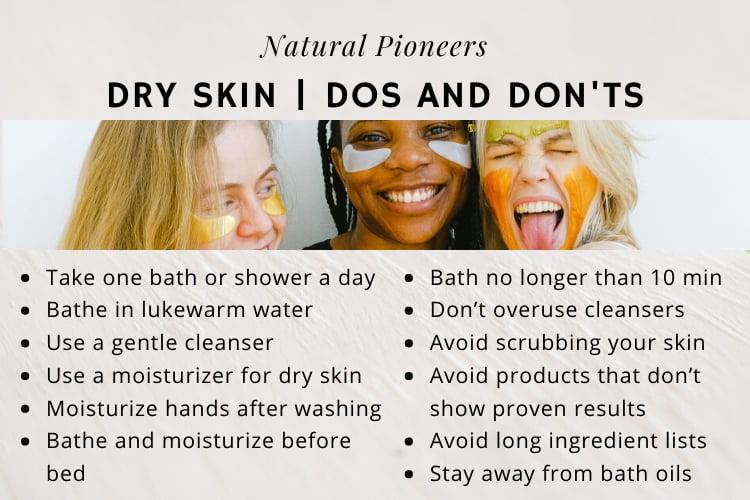
3. Best 5 Bath Salts | Evidence-Based Ranking
#1 Best Bath Salt For Dry Skin: Dead Sea Salts
The Dead Sea is a salt lake and the biggest natural saline reserve in the world. Regular table salt consists of about 98% sodium, while Dead Sea salts contain only about 8% sodium.
Dead Sea Salts are made up of about 60% magnesium and potassium, 8% sodium and some rare minerals.
A common misconception is that Dead Sea salts can be used as seasoning. While a small percentage of extracted Dead Sea salts are washed and processed to edible salt, the majority is not.
Regular Dead Sea salts are not safe for consumption and taste quite bitter.
Curious about Himalayan salt? Dead Sea Salts Vs. Himalayan Salt | 7 Surprising Differences
Dead Sea salts are our #1 best bath salt for a good reason. No other salt has science-backed benefits in those vast amounts. It works – and has been working for hundreds of years.
The main benefits of sea salt are seen were seen in studies that used 100% Dead Sea mud or Dead Sea salts. Make sure you choose 100% Dead Sea salts when trying to achieve similar results as seen in studies. I know, it doesn’t sound too sexy. No fancy bottle, no colorful salt and no added aromas. To make up for it, you’ll get something THAT WORKS! Natural and effective. And remember, if you fancy aroma therapeutic oils, feel free to add some drops.
Benefits of Dead Sea salts:
- Dead Sea salt baths at home reduce skin breakouts by up to 35%. Dead Sea salts have a healing effect and reduce inflammation, skin roughness, and redness. [15]; [16]; [17]
- Dead Sea mineral baths restore moisture and enhance skin hydration. Dead Sea minerals contain a natural moisturizing factor that can improve the look of damaged skin. [18]
- Dead Sea baths reduce aging sings on human skin. Dead Sea minerals have a rejuvenating effect on your skin. [19]
- Dead Sea mud accelerates the wound healing process. [20]
- Studies show Dead Sea spa therapy helps with psoriasis. [21]
Make sure you use 100% Dead Sea salts with no added ingredients to achieve the same effects as seen in studies.
How To Do A Dead Sea Salt Bath For Dry Skin:
- Start running warm water into a clean bathtub. Be sure it’s not too hot as hot water can aggravate inflamed skin and draw moisture from your skin. You should soak no longer than 10 minutes.
- Add 1/2 cup of Dead Sea salts under the running tap and mix with your hand until completely dissolved. Unwashed Dead Sea salts will leave a mud film on the tub – it wipes off easily.
- After bathing, pat the skin lightly with a soft towel, leaving it slightly damp.
- Within three minutes, liberally apply a moisturizer for dry skin all over the body. The three-minute time frame ensures your skin is still damp and won’t dry out any further. Make sure to avoid added perfumes and irritants in your lotion.
Conclusion: Dead Sea salts are our #1 best bath salt for dry skin. Centuries of use and numerous studies prove that Dead Sea salt baths are beneficial for many skin diseases including dry skin. Dead Sea salts also help with acne, psoriasis, redness, and signs of aging. Dead Sea salts are considered safe according to laboratory analyses.
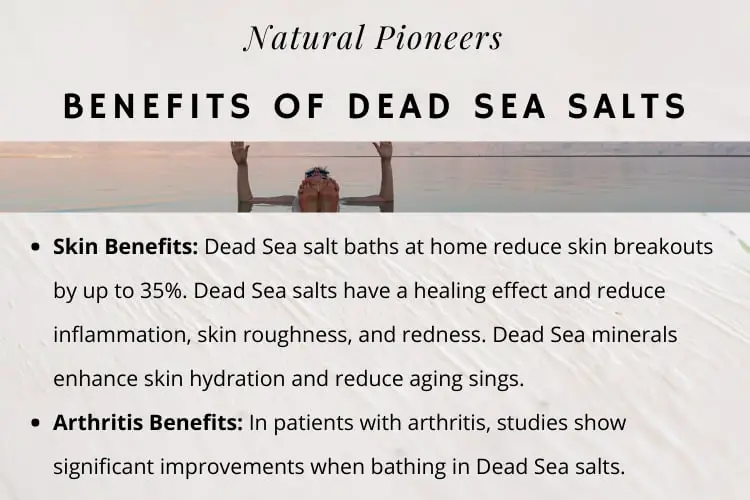
#2 Best Bath Salt For Dry Skin: Colloidal Oatmeal
Colloidal oatmeal is a centuries-old treatment for a variety of skin conditions, including dry skin, rashes, erythema, burns, itch, and eczema. Colloidal is a term defining the tiny size of the oat particles. Colloidal oatmeal has particles ranging between 1 and 1000 nanometers in diameter, much smaller than can be achieved in a home setting.
Wait a minute – you might say – this is not a bath salt. Or is it? While most people think of sodium when they hear the word salt or salts, bath salts actually refers to “mineral salts” and colloidal oatmeal is packed with many minerals that are great for our skin.
Colloidal oatmeal is commonly used in bath powders, cleansers, and moisturizers. It contains a broad spectrum of components that provide a number of skin care benefits. [22]
Composition and beneficial properties of colloidal oatmeal: [23]
- Proteins: Help maintain the skin barrier
- Polysaccharides and lipids: Replenish the skin barrier
- Vitamin E: Antioxidant
- Saponins: Cleansing
- Enzymes: Antioxidants
Studies find colloidal oatmeal improves the overall skin condition with its soothing, moisturizing and protective properties. Moreover, colloidal oatmeal is used in the treatment of several skin conditions including dry skin and eczema. An ideal and natural choice that ranks #2 in our best bath salt for dry skin review.
Benefits Of Colloidal Oatmeal:
- Soothing: According to the US Food and Drug Administration (FDA), colloidal oatmeal has a soothing effect that alleviates itching and irritation. Leave-on emollients with colloidal oatmeal seem to be most beneficial in the treatment of dry skin and eczema [24]; [25]
- Anti-inflammatory: A study using colloidal oatmeal lotion found the anti-inflammatory activities to be the reason for its effectiveness in treating of dry, irritated skin [26]
- Antioxidant activity: Colloidal oatmeal shows antioxidant activities that benefit dry, irritated skin [27]
- Helps with eczema: Colloidal oatmeal has been shown beneficial in the treatment of atopic dermatitis and resulted in significantly improved symptoms and severity of eczema [28]; [29]
- Itch-relief: A study on colloidal oatmeal cleanser and colloidal oatmeal cream showed significant improvement in itching, dryness, roughness, and severity after 4 weeks of use [30]
- Protects our skin: Colloidal oatmeal forms a protective film on the skin. Colloidal oatmeal serves as a pH buffer helping to maintain a healthy skin surface pH [31]; [32]
- Moisturizer: With its moisture-retention properties, colloidal oatmeal keeps our skin smooth [33]
- Better skin: After 4 weeks of using a colloidal oatmeal regimen, including colloidal oatmeal cleanser and colloidal oatmeal cream, studies demonstrated an overall improvement in skin condition [34]; [35]
According to studies, colloidal oatmeal is beneficial in dry sky. Several studies on colloidal oatmeal cleanser and cream indicate additional benefits for dry skin.
How To Do A Colloidal Oatmeal Bath For Dry Skin:
- Start running warm water into a clean bathtub. Be sure it’s not too hot as hot water can aggravate inflamed skin and draw moisture from your skin.
- Add about 1 cup of colloidal oatmeal under the running tap and mix with your hand until completely dissolved.
- Once the water has reached the proper level, the water should be milky and feel silky on your skin.
- After bathing, pat the skin lightly with a soft towel, leaving it slightly damp.
- Within three minutes, liberally apply a moisturizer for dry skin all over the body. The three-minute time frame ensures your skin is still damp and won’t dry out any further. Make sure to avoid added perfumes and irritants in your lotion.
Want to make your own colloidal oatmeal? Read on: How To Make Colloidal Oatmeal | Homemade Recipe & Benefits
Conclusion: Colloidal oatmeal is our #2 best bath salt for dry skin. Colloidal oatmeal is made by grinding whole oats into a fine powder, with particles much smaller than oat flour. Studies confirm its cleansing, protecting, soothing, and skin improving properties. In addition to colloidal oatmeal baths, colloidal oatmeal cleansers and creams prove effective for treating dry skin.
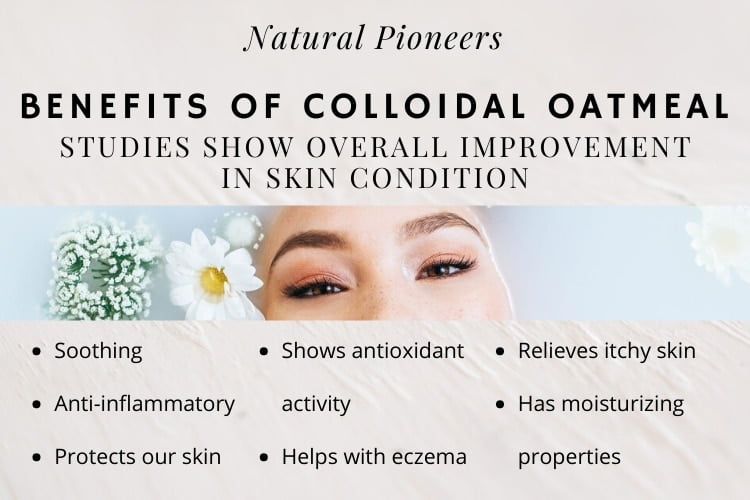
#3 Best Bath Salt For Dry Skin: Rice Starch
You read that right, our #3 best bath salt is rice starch. Adults, especially women using various cosmetic products commonly suffer from SLS (sodium lauryl sulfate) damaged skin. SLS is a common ingredient in beauty products, washes, cleaning products and even toothpaste.
Rice starch as a bath additive has shown beneficial when treating SLS-damaged skin: 15 min baths twice a day in bath water with added rice starch led to a 20% improvement on the healing capacity of damaged skin. Rice starch powder is a recommended skin repair bath additive for barrier damaged skin. [36]
How To Do A Rice Starch Bath For Dry Skin:
- Start running warm water into a clean bathtub. Be sure it’s not too hot as hot water can aggravate inflamed skin and draw moisture from your skin.
- Add about 1/2 cup of rice starch powder and mix with your hand until the starch has completely dissolved.
- Once the water has reached the proper level, the bath water should be milky and have a silky feel on your skin.
- After bathing, pat the skin lightly with a soft towel, leaving it slightly damp.
- Within three minutes, liberally apply a moisturizer for dry skin all over the body. The three-minute time frame ensures your skin is still damp and won’t dry out any further. Make sure to avoid added perfumes and irritants in your lotion.
Again, make sure you choose 100% rice starch with no added ingredients to achieve similar results as seen in studies. Plus avoid added ingredients that could potentially harm your skin.
Conclusion: Rice starch is the #3 best bath salt for dry skin. Studies on rice starch led to a 20% improvement on the healing capacity of damaged skin. About 1/2 cup of rice starch powder per bath tub has shown to be effective for skin repair.
#4 Best Bath Salt For Dry Skin: Sea Salt
Our #4 best bath salt for dry skin is sea salt. According to studies, sea salt shows a beneficial healing effect on skin when used as a bath additive. [37]
In case you’re wondering: Will swimming in the ocean help my skin?
Many of us have heard the summer tale that ocean water will cure minor cuts and wounds. There is no evidence for that. In fact, the opposite might be true. Swimming in salty ocean water alters the skin microbiome and may increase the likelihood of infection, according to studies. [38]; [39]; [40]
In addition, most coastal areas receive untreated runoff from a series of storm drains throughout the year. Studies found higher risks for respiratory and gastrointestinal infections in researched coastal regions. [41]
Make sure that you take your salt bath at home, using clean water and a quality sea salt.
How To Do A Sea Salt Bath For Dry Skin:
- Start running warm water into a clean bathtub. Be sure it’s not too hot as hot water can aggravate inflamed skin and draw moisture from your skin.
- Add 1 cup of sea salt under the running tap and mix with your hand until completely dissolved.
- After bathing, pat the skin lightly with a soft towel, leaving it slightly damp.
- Within three minutes, liberally apply a moisturizer for dry skin all over the body. The three-minute time frame ensures your skin is still damp and won’t dry out any further. Make sure to avoid added perfumes and irritants in your lotion.
Curious about Epsom salt? Read more: Dead Sea Salts Vs. Epsom Salt | The Difference
Conclusion: Sea salts are our #4 best bath salt for dry skin. Studies show that sea salt baths have a healing effect on skin. Make sure to use clean water and a quality sea salt.
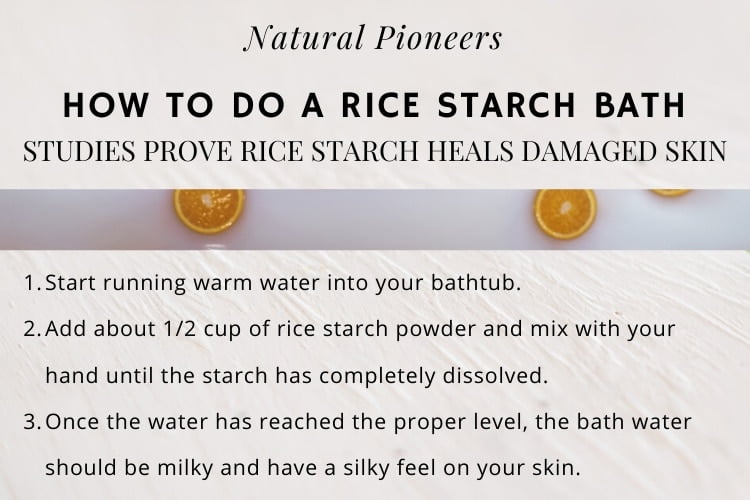
#5 Best Bath Salt For Dry Skin: The Salt-Free Bath
Yes, salt-free, that means only water. Probably not what you had expected, huh? Turns out, the majority of popular bath additives are more likely to damage and dry out your skin even more. Bathing in just warm water is the solution. We didn’t make that up – there is scientific evidence for bathing just in water.
And who doesn’t enjoy a simple, nice bath after a busy day? The warmth seems to facilitate mental and physical relaxation within seconds, and after a couple of deep breaths we’re completely absorbed by this blissful indulgence.
Here, we’ve included benefits that go beyond the treatment of dry skin. They are good to know, since you’ll benefit from all of them regardless of what bath salt in our ranking of the best 5 bath salts you choose. Here’s what studies say.
Benefits Of Baths For Dry Skin:
- Warm water baths combat chronic low-grade inflammation [42]
- Baths reduce fasting glucose and improve overall glucose metabolism [43]
- Heat therapy has widespread effects on vascular function and may improve cardiovascular health [44]; [45]
- Warm baths help with insomnia: Baths before bed result in significantly “deeper” and more restful sleep [46]
- Warm baths help with type 2 diabetes: Baths activate HSP72, which blocks inflammation and protects against obesity-induced insulin resistance [47]
- Baths keep us healthy! Studies find that bathing results in significantly better general health and mental health, including: lower stress, lower tension-anxiety, lower anger-hostility, and lower depression levels [48]
- Some call it detox effect: Baths induce increased blood flow and metabolic waste elimination [49]
- Relaxing in a bath burns about 130 calories, equal to the of a 30-minute walk [50]
Curious about the best natural bath additives? Read more: What Is A Good Natural Bath Salt | Natural Bath Additives
Conclusion: Best bath salt for dry skin #5 is the no-salt bath. While it may seem out of the ordinary, warm baths themselves have a lot to offer. The health benefits contribute to more well-being and sleep, which in turn activate the self-regulating forces of your body. Most importantly, you make sure you don’t cause any further damage to your skin through toxins in popular bath salts.
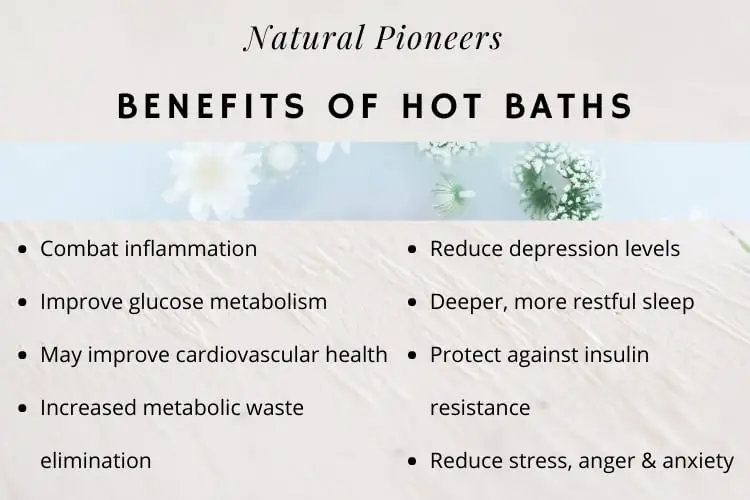
5. Conclusion
#1: Based on our research and the extensive list of studies provided in this article, Dead Sea salts are our #1 best bath salt for dry skin. Centuries of use and numerous studies prove that Dead Sea salt baths are beneficial for many skin diseases including dry skin. Besides dry skin, Dead Sea salts help with acne, psoriasis, redness, and signs of aging. Dead Sea salts are considered safe according to laboratory analyses.
#2: Colloidal oatmeal is our #2 best bath salt for dry skin. Colloidal oatmeal is made by grinding whole oats into a fine powder, with particles much smaller than oat flour. Studies confirm its cleansing, protecting, soothing, and skin improving properties. In addition to colloidal oatmeal baths, colloidal oatmeal cleansers and creams prove effective for treating dry skin.
#3: Rice starch is the #3 best bath salt for dry skin. Studies on rice starch led to a 20% improvement on the healing capacity of damaged skin. About 1/2 cup of rice starch powder per bath tub has shown to be effective for skin repair.
#4: Sea salts are our #4 best bath salt for dry skin. Studies show that sea salt baths have a healing effect on skin. Make sure to skip the ocean and use clean water at home with a quality sea salt.
#5: Our best bath salt for dry skin #5 is the no-salt bath. While it may seem out of the ordinary, warm baths themselves have a lot to offer. The health benefits contribute to more well-being and sleep, which in turn activate the self-regulating forces of your body. Most importantly, you make sure you don’t cause any further damage to your skin through toxins in popular bath salts.

